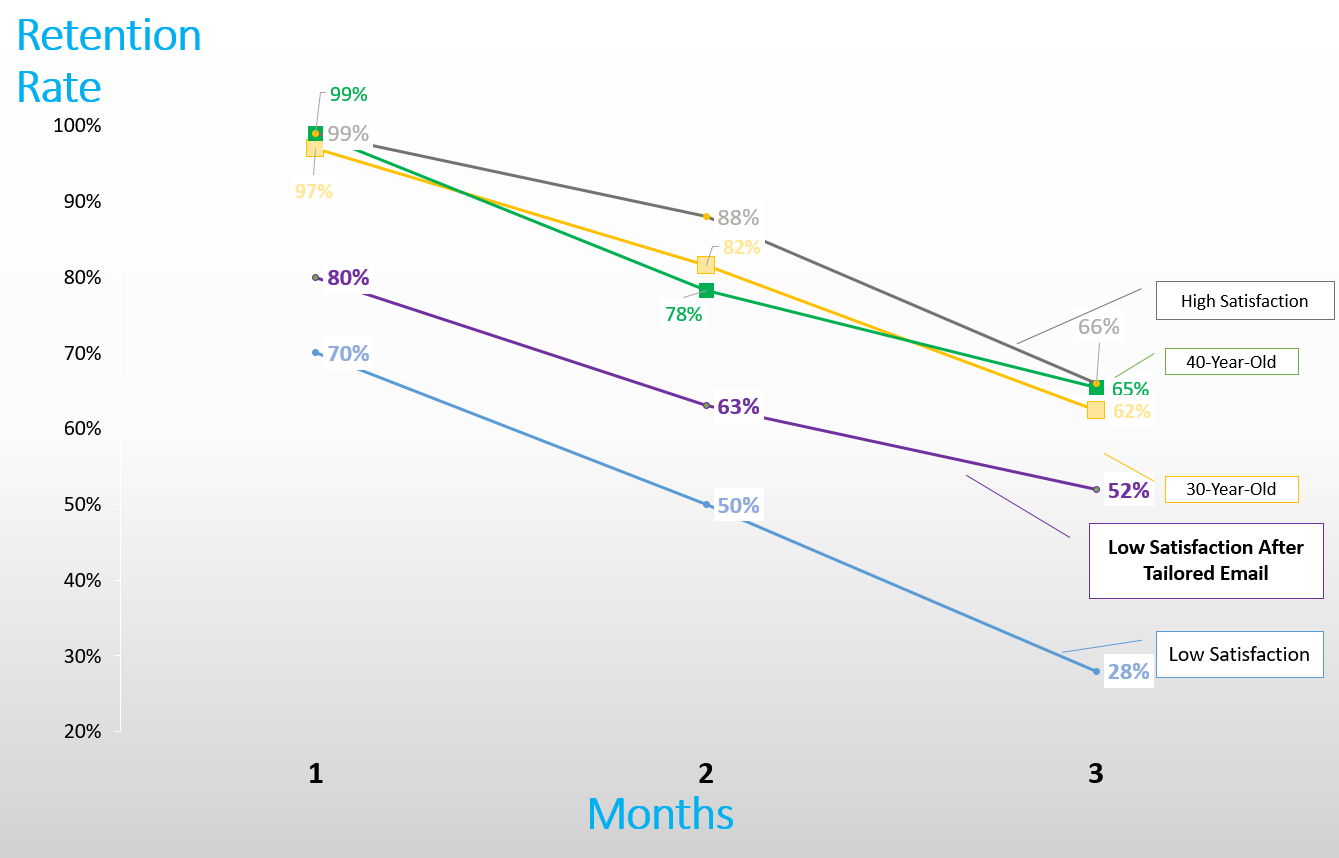What Gets Measured Can Be Better Managed
We manage lots and lots of thing that we don’t measure at all or well. That’s the nature of business and human enterprises.
But, I’d argue measuring makes managing better. The question isn’t can we measure or should we but rather, what’s worth measuring. ‘Worth it’ is often traded off for easy. Take engagement data. No please, take it. It’s mostly worthless.
Age is another that’s easy to ask or append and seemingly useful. After all, there’s a moderate correlation between it and retention and likelihood to donate in the first place.
Take a look at this data from the DonorVoice team. These are newly acquired sustainers showing the percentage making Month 1-3 payments broken out by a few factors.

- Green and yellow breaks out age, 40 and 30 average respectively.
You can set age quotas and floors and this is probably worth doing. But, once it’s done, it’s done. Your new line will move from yellow to green but there is no other intel to use or apply.
- Now check out the bottom, blue, and top, gray, lines – low and high satisfaction with the acquisition experience. This can be measured with humans (event, F2F, TM) and digital check-out.
One tell tale sign of a measure that isn’t worth measuring is when there’s no variance, no difference in the high and low of it. Another is when the high and low of your measure don’t link to business outcomes.
Satisfaction, at least the way we measure it, doesn’t suffer this fate, it passes the smell test. There’s variance with people living way down on blue and way up on gray and a strong link to the outcome we care about and in the direction we’d expect; low satisfaction people walking out the back door at a very high rate compared to high satisfaction.
The most interesting line is the purple one. It showcases the third condition for any measure worth measuring – changing something because of it and seeing a positive outcome.
Measuring is only worth doing if we’re going to do something different because of it. In this case we intervened with the low satisfaction folks living on the Blue line. This intervention was a tailored message responsive to the feedback provided. It’s an automated conversation; you say something and I respond in a way that shows I listened.
The business benefit of acting human is lift. People float from the blue line to the purple one. Cause and effect. There is no amount of conversation I can have with the 30 year old to make them 40. And knowing they’re 30 tells me nothing about what to say in that automated conversation. Same for their giving amount, transaction method, channel, RFM data and clicking behavior- all outcomes, not explanatory and not causal. Merely descriptive.
And I’d much rather describe someone on traits that explain their why than on those that merely describe.
Satisfaction, Identity, Personality, Beliefs, Opinions, this is the data worth measuring and if not measured makes your donor management very incomplete.
Kevin



Oh, heck. My math skills are so withered (if they ever existed). Thanks to some IQ test, I got slotted into the elite-nodding “college track” in high school … which meant tsunamis of science + of math; tsunamis I fled from, wearing a ring float with a swan’s head. However, I promise: I will read and re-read this until it penetrates my aging brain … enough for me to be solemnly prescriptive to a client. Still, I’m begging you: “Two eggs over easy, with the house hash browns, drizzled with Southwestern cheese sauce … AND an executive summary.”
Hi Tom, I doubt this was the point of your comment but my Pavlovian instincts kicked and I got hungry thinking about eggs, hash browns and cheese sauce. Here is that Executive Summary, but I cheated and had ChatGPT do it.
• Measuring makes managing better
• What’s worth measuring isn’t the same as what’s easiest to measure or most commonly measured. As an example, age is easy to measure but not very useful for managing
• Traits explaining “why,” such as satisfaction, identity, personality, beliefs, and opinions, are worth measuring.
• Descriptive data, such as giving amount, transaction method, channel, RFM data, and clicking behavior, are not telling us why, merely describing what, when or how. Engagement data is what and when data that is mostly worthless because it doesn’t even link to business outcomes
• A measure is only worth measuring if we’re going to do something different because of it
• Finding out who had a bad experience and trying to fix it is improves business outcomes.